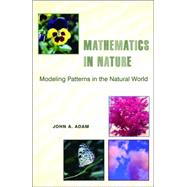
Note: Supplemental materials are not guaranteed with Rental or Used book purchases.
Purchase Benefits
What is included with this book?
| Preface to the Paperback Edition | xiii | ||
| Preface The motivation for the book; Acknowledgments; Credits | xv | ||
| Prologue Why I Might Never Have Written This Book | xxiii | ||
| CHAPTER ONE The Confluence of Nature and Mathematical Modeling | 1 | (16) | |
|
|||
|
|||
|
|||
| CHAPTER TWO Estimation: The Power of Arithmetic in Solving Fermi Problems | 17 | (14) | |
|
|||
| CHAPTER THREE Shape, Size, and Similarity: The Problem of Scale | 31 | (26) | |
|
|||
|
|||
|
|||
|
|||
|
|||
|
|||
| CHAPTER FOUR Meteorological Optics I: Shadows, Crepuscular Rays, and Related Optical Phenomena | 57 | (23) | |
|
|||
|
|||
|
|||
|
|||
| CHAPTER FIVE Meteorological Optics II: A "Calculus I" Approach to Rainbows, Halos, and Glories | 80 | (38) | |
|
|||
|
|||
|
|||
|
|||
| CHAPTER SIX Clouds, Sand Dunes, and Hurricanes | 118 | (21) | |
|
|||
|
|||
| CHAPTER SEVEN (Linear) Waves of All Kinds | 139 | (34) | |
|
|||
|
|||
| CHAPTER EIGHT Stability | 173 | (21) | |
|
|||
| CHAPTER NINE Bores and Nonlinear Waves | 194 | (19) | |
|
|||
| CHAPTER TEN The Fibonacci Sequence and the Golden Ratio (τ) | 213 | (18) | |
|
|||
| CHAPTER ELEVEN Bees, Honeycombs, Bubbles, and Mud Cracks | 231 | (23) | |
|
|||
|
|||
|
|||
|
|||
| CHAPTER TWELVE River Meanders, Branching Patterns, and Trees | 254 | (41) | |
|
|||
|
|||
|
|||
| CHAPTER THIRTEEN Bird Flight | 295 | (14) | |
|
|||
|
|||
|
|||
| CHAPTER FOURTEEN How Did the Leopard Get Its Spots? | 309 | (27) | |
|
|||
|
|||
|
|||
| APPENDIX Fractals: An Appetite Whetter | 336 | (5) | |
| BIBLIOGRAPHY | 341 | (16) | |
| INDEX | 357 |
The New copy of this book will include any supplemental materials advertised. Please check the title of the book to determine if it should include any access cards, study guides, lab manuals, CDs, etc.
The Used, Rental and eBook copies of this book are not guaranteed to include any supplemental materials. Typically, only the book itself is included. This is true even if the title states it includes any access cards, study guides, lab manuals, CDs, etc.